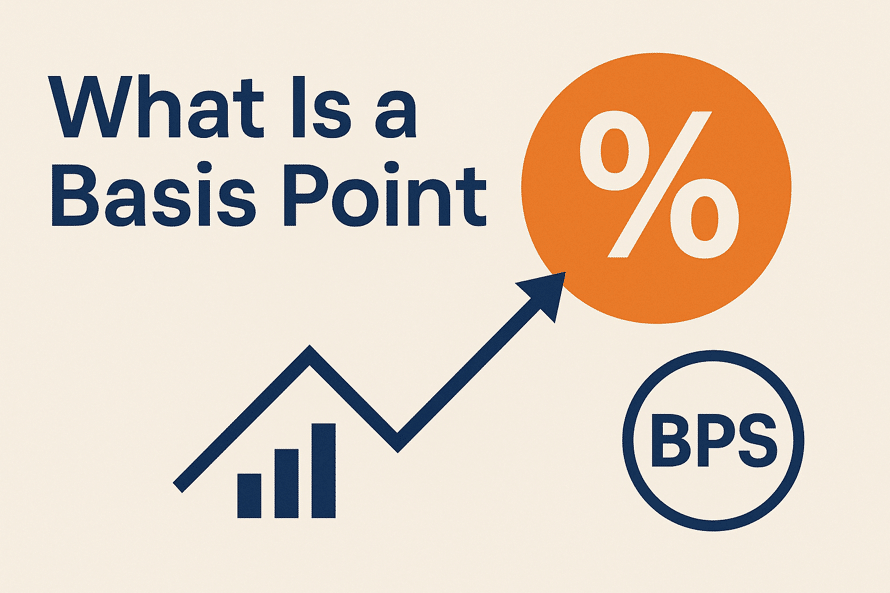
Changes in interest rates or returns, however small, can impact an economy in more ways than one. That’s why basis points, which are also called bps or bips, are essential in finance to measure the change in the value of financial instruments. A basis point is equal to one-hundredth of a percent, so it is 0.01%. Mostly, it is applied to changes in interest rates, bond yields, and various financial figures.
BPS reduces the chances of getting lost in confusing details when referring to small percentage changes. Since basis points impact financial decisions and the market, investors, bankers, and borrowers should understand what is a basis point as it impacts their operations.
Definition and Meaning of Basis Points
When measuring little changes in interest rates, yields, or percentages, finance uses the unit called basis points (BPS). A basis point is equal to 0.01% of a certain number. BPS is a tool that, when used by financial experts, makes it simple to describe changes. Are you thinking about what is a basis point? Simply put, this is a standardized way to show changes in percentages, especially in bonds and lending activities.
How Much Is 1 Basis Point in Percentage Terms?
One basis point is 0.01%. That shows that each 100 basis point is equivalent to 1% of the total interest. The numbers increase further, so 10,000 basis points stand for 100%. That makes it possible to portray even slight modifications in exact detail.
Why Financial Professionals Use Basis Points
Investors and analysts find it easier to describe rate changes with BPS than any other method. It ensures that it does not mix up handling absolute and relative percentages. Since most changes in the interest rate are measured in basis points, they are helpful and easy to communicate.
Where Are Basis Points Used in Finance?
The word ‘basis’ in the basis point describes the space or difference between two interest rates or percentages. Most changes are small and essential, so the movement is often reported using basis points for precision.
It highlights the need to understand how basis points are used in finance for more accuracy. Let’s learn where you can use them.
Central Bank Interest Rate Announcements
Central banks, such as the RBI and the Federal Reserve, typically adjust interest rates by using basis points. In other words, a 25 basis point hike is the same as a 0.25% rise. This method is less confusing when discussing minor shifts in rates that affect the economy as a whole.
Bond Yields and Yield Spreads
Bond traders measure changes in bond yields using basis points. When the yield on a government bond grows from 6.50% to 6.75%, it has risen by 25 basis points. To compare the yield of two bonds closely, people refer to the difference in basis points instead of percentage points.
Mutual Funds and Management Expense Ratios (MERs)
Often, the MER (management expense ratio) for a mutual fund is expressed in basis points. In other words, if a MER is 100 basis points, you are charged an effective 1% fee. It provides investors with an easy way to compare expenses and choose among funds.
Loan Offers and Credit Spreads
Basis points help lenders clarify how much extra they apply to a reference rate. In other words, when the home loan rate is 200 basis points above the repo rate, the interest is 2% over the repo rate.
Why Basis Points Help Avoid Confusion
No wonder readers often struggle to understand when financial rates or percentages are discussed. In these situations, basis points offer numerous benefits. However, make sure you understand what is a basis point. By using basis points, you can tell when there are changes and avoid possible confusion.
Absolute vs Relative Percentage Changes
We frequently contrast recent data with historical data when reading labor market indicators. The simple difference between the two periods is known as absolute change. This difference is expressed as a percentage of the previous value using relative change.
Even indicators that are already expressed as percentages, such as the unemployment rate, can benefit from these ideas. In this case, relative change displays the percentage difference from the value of the initial period, whereas absolute change is expressed in percentage points.
Examples Where Basis Points Improve Clarity
If a bank decides to increase its interest rate by 0.25%, it will influence the economy in many ways. It is clearer and less risky to say “25 basis points” than to use the term “25 basis.” To use another example, when a stock price goes up from 3.00% to 3.10%, it’s simpler to talk about the 10 basis point increase rather than 0.10%. That way, it’s clear that the rise is not 3.33%, as it would be if we looked at this as a percentage.
Real-World Examples of Basis Point Usage
The change in interest rates or investment income is expressed in basis points. We will look at real-world examples here.
RBI and Federal Reserve Policy Rate Changes
Often, changes in a policy rate are described in basis points by central banks. The RBI made a 50-point cut to the repo rate on June 6, 2025, to boost growth. The US Federal Reserve also raised rates to help combat inflation.
Mutual Fund Fees and ETF Expenses
When dealing with mutual funds and ETFs, basis points are usually used as a measure of expense ratios. For instance, when an expense ratio is 0.75%, the investor is charged 75 basis points every year. Another way to put it, an ETF that charges 0.10% is said to have an expense ratio of 10 basis points.
A minor difference in this area over the years can significantly impact your overall returns from significant investments. That’s why investors usually review funds by their basis points (bps) to measure their fees. Higher returns in the long run are more likely when costs are low because of the lower BPS.
Corporate Bond Yield Differentials
Interest rates are frequently raised or lowered by a specific number of basis points by central banks. A 25 BPS increase, for instance, results in a 0.25% increase in interest rates. When discussing changes in interest rates and bond yields, traders utilize basis points.
BPS is frequently used to express the price difference between two bonds. Using basis points guarantees clarity, particularly when comparing fixed-income investment credit spreads or marginal changes in interest rates across different corporate issuers.
Basis Points vs. Percentage Points
Understanding the difference between basis points and percentage points is helpful in the field of finance. If you wonder about what is a basis point, it is a unit that shows very small differences in interest rates or financial percentages.
Table: Basis Point to Percentage Conversion
| Basis Point | Percentage |
| 1 | 0.01% |
| 10 | 0.1% |
| 50 | 0.5% |
| 100 | 1% |
| 1000 | 10% |
| 10000 | 100% |
You can change basis points into percentages and do the opposite without using a conversion template or chart by using the given method:
Basis points to Percentage – Divide the points by 100
Changing to basis points – Take the percentage and multiply by 100
When to Use BPS vs Percentage Change
By using basis points, it is easier to explain slight changes in interest rates. A rise from 2.00% to 2.25% in the interest rate means the interest rate increased by 25 basis points, not by 0.25%. It is more understandable in financial reports to write “25 basis points” than “0.25 percent.”
Discussing larger or more fundamental changes often involves percentage points. All in all, use basis points to show exact and small changes, mainly in financial situations. Keep track of significant changes over the whole period with percentage points.
Importance of Basis Points in Indian Finance
Using basis points, people can easily see accurate minor rate variations in loans, bonds, and investments. Learning what is a basis point will show you its significance.
RBI Monetary Policy Use
Change in policy rates by the RBI is often expressed in basis points. The central bank unexpectedly announced a 50 basis point reduction of the repo rate, bringing it down to 5.5% on June 6. Moreover, it brought down the expected inflation by 30 basis points to 3.7% and reduced the cash reserve ratio by 100 basis points to 3%. Although these adjustments are only calculated in BPS, they have a significant impact on the economy.
BPS in Indian Bond and Loan Markets
Instruments such as Treasury bonds and corporate bonds use basis points to display their interest rate fluctuations. Rate changes for credit cards are described in bps. In these markets, BPS illustrates shifts in the rates of return. By understanding basis points, investors and borrowers can track slight changes in their rates.
Conclusion: Why Basis Points Matter in Financial Communication
When communicating in finance, basis points are crucial. They make it clear how slight changes in interest rates, returns, and fees happen. If they were not used, numbers might be difficult to understand. It is simple to compare different financial choices using a basis point.
For example, it is much simpler to explain 25 basis points than 0.25%. For this reason, people should know what is a basis point when making financial decisions.
FAQs
1. What is 1 basis point in percentage terms?
A basis point is equivalent to 0.01% when looked at as a percentage. Such tools help describe minor adjustments in interest rates or yields.
2. Why do banks and central banks use basis points?
Banks and central banks use basis points to communicate small changes in interest rates without confusion. Since even minor rate adjustments can significantly impact the economy, basis points offer a precise and standardized way to express these shifts.
3. How many basis points equal 1%?
Every hundred basis points is represented by 1 percent. Measuring things this way allows for accurate and straightforward discussions about interest rate fluctuations.
4. Is a basis point always equal to 0.01%?
Yes, a basis point is always just 0.01%. This ensures that reporting, interest rates, and bond trading remain consistent.
5. How do I calculate changes using basis points?
Take the number of basis points and multiply by 0.01 to change it into a percentage. As an illustration, 25 basis points are the same as 0.25% (0.25 = 25 × 0.01).
6. Can BPS be negative in financial terms?
Basis points can sometimes end up negative, primarily when rates or yields fall. A 25-basis-point decrease indicates that the rate has decreased by 0.25%.
7. What is the difference between BPS and percentage points?
One basis point is 0.01%, and one percent point is 100%, or simply 1%. For example, increasing from 2% to 3% is a 1 percentage point increase, equivalent to 100 basis points (bps).
8. Are basis points used in India’s RBI announcements?
Rate changes made by the Reserve Bank of India are usually stated in basis points. The clear and precise language in statements and reports helps with monetary policy.







